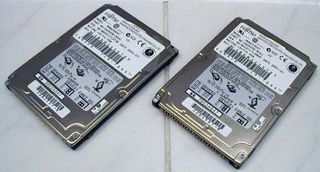IDE-RAID With Notebook Drives: Quick And Quiet
RAID With 2.5" Hard Drives: Quick And Quiet
The article first appeared in Tom's Hard News Email Newsletter

For many of us, there is a constant desire to increase the performance of our PC. To this end, a high-speed processor, a generous amount of RAM and a reliable motherboard are necessities. However, the hard disk drive plays a very important role, as well. For instance, whether you want to run a huge application or start Windows, both the system and the user have to wait for the data output from the disk drive - this slows us down.
Over the years, the industry has brought us higher capacity and faster drives. Yet they come at a price: the disturbing noise generated while idling and accessing have been the center of much discussion, leading to significant efforts towards reducing the annoyance. This is especially important because the powerful fans needed for todays top PC systems (used to cool the CPU, the graphics chip and the power supply unit) only contribute to the acoustic harassment.
Choosing your components wisely is still the best way to keep the noise level to within an acceptable range. But one of the primary sources of noise, the hard drive, will be with us for many years.
Nevertheless, there are quieter models. Notebook drives (2.5" models) run at reduced rotation speed and are therefore very quiet. The only disadvantage involved is that they have much lower performance.
Usually, the disk subsystem performance is increased by setting up RAID arrays with several drives. Data is equally spread to all drives (so-called striping), resulting in much higher performance due to the simultaneous activity of all drives. Such a RAID 0 array can of course be established with 2.5" - in the end, they are nothing more than mini IDE drives. In this article, we take a closer look at the performance level that can be reached by such an array.
Stay on the Cutting Edge
Join the experts who read Tom's Hardware for the inside track on enthusiast PC tech news — and have for over 25 years. We'll send breaking news and in-depth reviews of CPUs, GPUs, AI, maker hardware and more straight to your inbox.
Current page: RAID With 2.5" Hard Drives: Quick And Quiet
Next Page IDE-RAID With Mini Hard Drives: THG Shows You HowMost Popular

